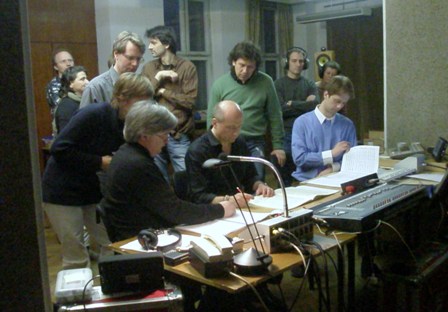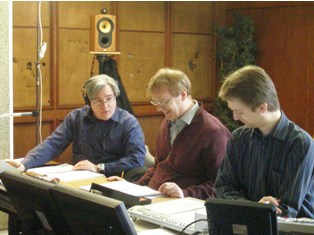 Front, left to right: Philip Traugott, Paavo Järvi and engineer Dirk Fischer with members of the Deutsche Kammerphilharmonie Bremen in control room at the Funkhaus Nalepastrasse in Berlin
Front, left to right: Philip Traugott, Paavo Järvi and engineer Dirk Fischer with members of the Deutsche Kammerphilharmonie Bremen in control room at the Funkhaus Nalepastrasse in Berlin

Funkhaus Nalepastrassee in Berlin
|
|
Järvi's chair and podium in the Funkhaus recording hall (note "sprng" on the podium, flowers in the background)
|
The Kammerphilharmonie, Järvi and Traugott are a special team, perhaps unique in today’s classical recording world. A self-governing orchestra, a brilliant conductor and a gifted producer bent on no less than perfection add up to a fertile union.
Järvi and Traugott are old friends, having met at a Conductors Guild workshop in Morgantown, West Virginia in 1987, when both were students. Though they did not record together until 2004, they share mutual trust and admiration as musicians, ensuring an optimal working relationship.
“Until I experienced the work of Paavo with Philip, my ideal team of conductor and producer was the Karajan/Glotz relationship” (Herbert von Karajan and Michel Glotz), said former producer and record company executive Gunther Breest. “He (Glotz) was able to make that man feel comfortable and trust him. These people – and Paavo is no different -- are tremendously secure in what they are doing, but I will never forget that I was coming out backstage with Karajan at the end of his lifetime in Carnegie Hall. He had conducted the Bruckner 8th and the pubic was going mad. He was standing behind, a shy man, asking me ‘do you really think that was good?’”
Breest spent 18 years at Deutsche Grammophon, including Karajan’s last years, before serving as president of Sony Classical worldwide. As a consultant for the Deutsche Kammerphilharmonie, he spearheaded their recently completed cycle of Beethoven symphonies, which netted Järvi the German recording academy’s 2010 ECHO Klaasik Conductor of the Year award for the 2nd and 6th Symphonies.
|
Deutsche Kammerphilharmonie Bremen and Paavo Järvi in the "Grossen Sendesaal" at the Funkhaus Nalepastrasse in Berlin (photo by Jean-Marie Geijsen)
|

from left: Philip Traugott, Jean-Marie Geijsen and Dirk Fischer in control room
|
Järvi cedes the guidance of the sessions to Traugott, whose job is to prime the orchestra with small rehearsals, then step aside and let Järvi and the orchestra make music.
[Breest observed this with great interest at the Beethoven sessions: “Paavo was never too proud. He had no ego, actually, at this moment. I was so surprised. He just sat back and let Philip work with each member of the Kammerphilharmonie. He took care of the balancing, the blending, the dynamic, all the technical details. Then Paavo took over again. He was able to have a tremendously well prepared team of musicians, and all the impetus of his emotions and all those things which make these recordings so outstanding, without any false pride by anyone involved.” The trust between Jarvi and Traugott is based on exhaustive preparation, too, Breest added. “Even before they went into the studio, they had worked on the score in tremendous detail and they knew exactly, mutually, what they wanted to achieve.”]
“Give us some charm and magic” and “Let’s go back and make some music” were typical instructions by Traugott after he had taken them through the many takes needed to do the job at the Schumann sessions. His responses to their work were often effusive: “Very great things there.” “Bravi tutti.” “Absolutely gorgeous.” He gave them lots of encouragement, too, like “Yes, you can. That’s personally from Obama himself.” And he spoke with the utmost tact: “[Bassoonist X] is making a beautiful sound on his A, but there is too much of it.”
In the Introduction to the first movement of the symphony, horns and trumpets make an “official announcement of Spring," answered immediately by the full orchestra. To create the effect of something coming from far away, Järvi asked the horns and trumpets to play from the back of the hall and to play less forte (loud) in order to create an even greater dynamic contrast when the full orchestra comes in fortissimo three bars later. Takes were made of this lontano (distant) version and also of the brasses playing from their seats within the orchestra. During a post-session pow-wow in the control room, each take was played back and Järvi chose the lontano version.
“Already in the very opening gestures of the Symphony, Paavo has created a special moment,” Traugott said afterward. “Purists may not agree, but these pieces have been recorded many, many times and he wants to put his own stamp on it so there’s a real narrative, a story in a sense, going on in the background.”
The slow movement (Larghetto), a love song for Schumann’s wife Clara, got heartfelt treatment by Järvi and the players, who sang the opening bars to practice the emotion of the music. When the actual take was made, the control room collectively sighed. “It’s very hard to read a score with tears in your eyes,” said Traugott.

Drama in the control room (photo by Jean-Marie Geijsen)
|
There was painstaking work on the trombone passage that connects the second and third movements (12 bars, 13 takes). This, too, yielded positive results and drew foot-shuffling “applause” from the orchestra.
The sessions were not without humor. “You and Elke can do it as much as you like,” said Traugott of a dramatic moment in the finale where the horns introduced a cadenza by the flute. “More rustic,” added Järvi.
After the final session on Sunday, the production crew met with Järvi and the players in the recording studio and hugs and kisses were exchanged all around. Then it was back to Bremen for the orchestra and to parts beyond for Traugott and Järvi, knowing that at least the first part of their work had been done.
(continued in "Creating a Recorded Legacy: Traugott, Järvi and the Deutsche Kammerphilharmonie Bremen" on this site)
Photos by Mary Ellyn Hutton and Jean-Marie Geijsen.